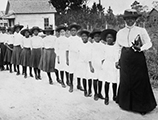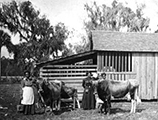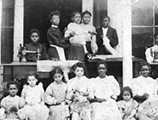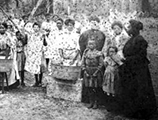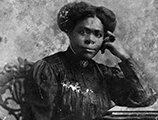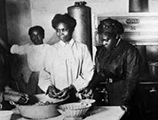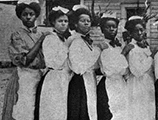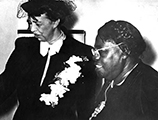Mary McLeod Bethune
Lesson Plans
Mary McLeod Bethune, Educator
Teacher's Guide for Photographs of Mary McLeod Bethune and Her School
Background Information
These photographs document the earliest days of Mary McLeod Bethune's school. The images depict the Daytona Normal and Industrial School students in front of their school, at their barn, in sewing and needlework classes, and washing laundry.
Use to Illustrate:
- Daily life at the Daytona Normal and Industrial School, ca. 1905-1912.
- The experience of students at the school.
- The work of Mary McLeod Bethune.
- Bethune's contribution to equal rights for African-Americans.
Document Analysis Worksheets
Created by the National Archives
Document analysis is the first step in working with primary sources. Teach your students to think through primary source documents for contextual understanding and to extract information to make informed judgments. The document analysis worksheets created by the National Archives and Records Administration are in the public domain.
- Photograph (PDF) (HTML)
- Written Document (PDF) (HTML)
- Poster (PDF) (HTML)
- Map (PDF) (HTML)
- Video (PDF) (HTML)
- Sound Recording (PDF) (HTML)
Next Generation Sunshine State Standards
- SS.4.A.1.1: Analyze primary and secondary resources to identify significant individuals and events throughout Florida history.
- SS.4.A.6.3: Describe the contributions of significant individuals to Florida.
Examples may include, but are not limited to, John Gorrie, Henry Flagler, Henry Plant, Lue Gim Gong, Vincente Martinez Ybor, Julia Tuttle, Mary McLeod Bethune, Thomas Alva Edison, James Weldon Johnson, Marjorie Kinnan Rawlings. - SS.4.A.8.1: Identify Florida's role in the Civil Rights Movement.
- SS.912.A.3.12: Compare how different nongovernmental organizations and progressives worked to shape public policy, restore economic opportunities, and correct injustices in American life.
- SS.912.A.7.7: Assess the building of coalitions between African-Americans, whites, and other groups in achieving integration and equal rights.
Florida Standards
- LAFS.4.RI.1.1: Refer to details and examples in a text when explaining what the text says explicitly and when drawing inferences from the text.
- LAFS.68.RH.1.1: Cite specific textual evidence to support analysis of primary and secondary sources.
- LAFS.68.RH.1.2: Determine the central ideas or information of a primary or secondary source; provide an accurate summary of the source distinct from prior knowledge or opinions.
- LAFS.910.RH.1.1: Cite specific textual evidence to support analysis of primary and secondary sources, attending to such features as the date and origin of the information.
- LAFS.910.RH.1.2: Determine the central ideas or information of a primary or secondary source; provide an accurate summary of how key events or ideas develop over the course of the text.
- LAFS.910.RH.3.9: Compare and contrast treatments of the same topic in several primary and secondary sources.
- LAFS.1112.RH.1.1: Cite specific textual evidence to support analysis of primary and secondary sources, connecting insights gained from specific details to an understanding of the text as a whole.
- LAFS.1112.RH.1.2: Determine the central ideas or information of a primary or secondary source; provide an accurate summary that makes clear the relationships among the key details and ideas.

 Listen: The World Program
Listen: The World Program